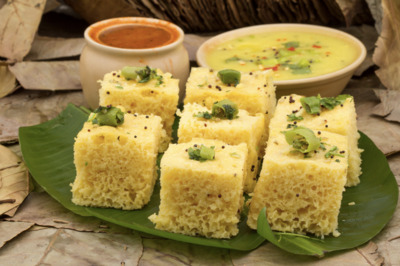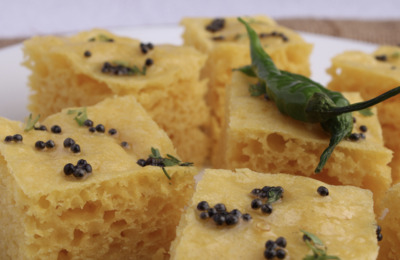If you’ve ever walked into a Gujarati house or stood staring into a sweet shop glass counter, you’ve 100% seen dhokla or khaman sitting there, all yellow and fluffy like they own the place. People eat them all the time — with chai, during festivals, when relatives randomly show up, or just because they’re bored and want to eat something. They look kind of the same, but nope, they’re not twins. They taste different, they’re made different, and honestly, both come with their own little personality. So no need to overthink — let’s just see what makes each one different and why it’s totally fine to love both.
What is dhokla?

Dhokla is this soft, squishy, yellow-ish snack that kind of looks like a sponge but doesn’t taste weird — it’s actually pretty great. It’s made from rice and urad dal that’s been sitting around fermenting (on purpose), and then it gets steamed until it turns all fluffy and bouncy. There’s a tiny bit of sourness from the fermentation, but it’s nice. It doesn’t feel heavy in your stomach, but somehow still fills you up.
People usually throw some mustard seeds, chopped coriander, and grated coconut on top — just to make it taste better and give it a bit of crunch.
And because it’s fermented, it has those good tummy bacteria that help you digest stuff properly. Also, it’s steamed, not fried, so there’s hardly any oil. You can eat it in the middle of the day, before chai, after chai, or whenever you just want to snack without feeling like you messed up your life.
What about khaman?

Khaman is made with chickpea flour, which is just besan — the regular yellow stuff you find in every kitchen. It’s also steamed like dhokla, but it looks more yellow-y and feels extra soft and kind of falls apart when you bite it. It’s a little sweet too, which tastes amazing. The reason it’s all puffy and bouncy is because people chuck in some baking soda or Eno, and boom — it rises fast. No long fermenting drama. Just mix the thing, steam it, and eat.
Khaman usually gets a louder tempering — like, mustard seeds popping everywhere, green chillies doing their thing, and curry leaves in hot oil. It gives the whole thing a nice spicy kick. Also, khaman tastes even better when you dunk it in green chutney or that sweet tamarind one. Everyone loves it.
Since it’s made with chickpea flour, it’s got a good amount of plant protein and fibre, which basically means it keeps you full and doesn’t crash your energy. Also, no gluten in there, so people who avoid wheat can eat it without stressing.
Key differences to remember
Both come from Gujarat and kind of use similar stuff, but they’re totally different when you actually eat them. Dhokla has this light sour taste and feels a bit grainy because it’s made with rice and dal. Khaman is sweeter, way fluffier, and kind of breaks apart when you touch it. Dhokla gets its tangy vibe from fermentation — you gotta wait for it. Khaman, on the other hand, just puffs up quickly with baking soda or Eno. No waiting, just steam and go.
If you ever get confused at a stall or restaurant, here’s the cheat code: khaman is bright yellow, super soft, and a little sweet. Dhokla is paler, a bit tangy, and feels more sponge-like when you bite into it.
Why you should love both
Both khaman and dhokla are proof that Gujarati food knows what it’s doing. They’re light, not oily, full of flavour, and you can eat them pretty much whenever — breakfast, with chai, random hunger moments, you name it.

And it’s not just about taste. They’re actually healthy too. You get some protein, fibre, and in dhokla’s case, beneficial gut-friendly bacteria that support digestion. They’re easy on the tummy and give you enough to get through the day — whether you’re running around or just lying on the sofa doing nothing.
So next time you want something tasty and light, try both! Whether you prefer the tangy, probiotic dhokla or the soft, protein-packed khaman, you’re in for a tasty treat that’s truly Gujarati. And honestly, you can’t go wrong with either!
What is dhokla?
Dhokla is this soft, squishy, yellow-ish snack that kind of looks like a sponge but doesn’t taste weird — it’s actually pretty great. It’s made from rice and urad dal that’s been sitting around fermenting (on purpose), and then it gets steamed until it turns all fluffy and bouncy. There’s a tiny bit of sourness from the fermentation, but it’s nice. It doesn’t feel heavy in your stomach, but somehow still fills you up.
People usually throw some mustard seeds, chopped coriander, and grated coconut on top — just to make it taste better and give it a bit of crunch.
And because it’s fermented, it has those good tummy bacteria that help you digest stuff properly. Also, it’s steamed, not fried, so there’s hardly any oil. You can eat it in the middle of the day, before chai, after chai, or whenever you just want to snack without feeling like you messed up your life.
What about khaman?

Khaman is made with chickpea flour, which is just besan — the regular yellow stuff you find in every kitchen. It’s also steamed like dhokla, but it looks more yellow-y and feels extra soft and kind of falls apart when you bite it. It’s a little sweet too, which tastes amazing. The reason it’s all puffy and bouncy is because people chuck in some baking soda or Eno, and boom — it rises fast. No long fermenting drama. Just mix the thing, steam it, and eat.
Khaman usually gets a louder tempering — like, mustard seeds popping everywhere, green chillies doing their thing, and curry leaves in hot oil. It gives the whole thing a nice spicy kick. Also, khaman tastes even better when you dunk it in green chutney or that sweet tamarind one. Everyone loves it.
Since it’s made with chickpea flour, it’s got a good amount of plant protein and fibre, which basically means it keeps you full and doesn’t crash your energy. Also, no gluten in there, so people who avoid wheat can eat it without stressing.
Key differences to remember
Both come from Gujarat and kind of use similar stuff, but they’re totally different when you actually eat them. Dhokla has this light sour taste and feels a bit grainy because it’s made with rice and dal. Khaman is sweeter, way fluffier, and kind of breaks apart when you touch it. Dhokla gets its tangy vibe from fermentation — you gotta wait for it. Khaman, on the other hand, just puffs up quickly with baking soda or Eno. No waiting, just steam and go.
If you ever get confused at a stall or restaurant, here’s the cheat code: khaman is bright yellow, super soft, and a little sweet. Dhokla is paler, a bit tangy, and feels more sponge-like when you bite into it.
Why you should love both
Both khaman and dhokla are proof that Gujarati food knows what it’s doing. They’re light, not oily, full of flavour, and you can eat them pretty much whenever — breakfast, with chai, random hunger moments, you name it.
And it’s not just about taste. They’re actually healthy too. You get some protein, fibre, and in dhokla’s case, beneficial gut-friendly bacteria that support digestion. They’re easy on the tummy and give you enough to get through the day — whether you’re running around or just lying on the sofa doing nothing.
So next time you want something tasty and light, try both! Whether you prefer the tangy, probiotic dhokla or the soft, protein-packed khaman, you’re in for a tasty treat that’s truly Gujarati. And honestly, you can’t go wrong with either!
You may also like

'A devotee slipped': Mansa Devi temple on what led to Haridwar stampede; 6 killed, dozens injured

Ruslaan Mumtaz shows his support to the ban on OTT platforms for objectionable content

Ankita Lokhande & Vicky Jain grateful for Laughter Chef 2 journey: 'We gained an extended family'

Shivraj Chauhan takes stock of development schemes

'Great wake-up call for conservatives': Yair Netanyahu slams Joe Rogan over 'antisemitic propaganda'; claims podcaster refuses to host Israeli PM





